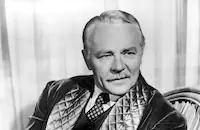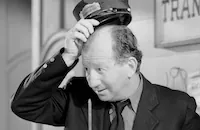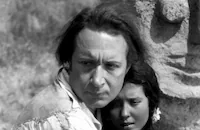Look for the Silver Lining

Brief Synopsis
Cast & Crew
David Butler
June Haver
Ray Bolger
Gordon Macrae
Charles Ruggles
Rosemary De Camp
Film Details
Technical Specs

Synopsis
In the 1930s, theatrical star Marilyn Miller becomes dizzy during a rehearsal. While she rests in her dressing room, she is reminded of her past when a man from her hometown of Findlay, Ohio brings her an old vaudeville poster announcing a performance of the Five Columbians, her family's act: Teenage Marilyn leaves school to join her parents and her sisters, Claire and Ruth, at the vaudeville theater where they are performing. There, she meets her idol, dancer Jack Donahue. After the entire family, except for Marilyn, is quarantined with the mumps, Jack invites Marilyn to dance and sing with him, and she is so popular that she is made a regular part of the family's act. While the Five Columbians are playing theaters in London, Jack brings a Broadway producer to see Marilyn perform alone, and, in 1914, she appears in her first Broadway show. She takes an instant dislike to her partner, Frank Carter, but when an investigator from the Gerry Society for the Prevention of Cruelty to Children correctly suspects that she is underage and demands her birth certificate, Frank invents a plausible story, and Marilyn is able to go on. On opening night, Frank gives Marilyn a small ceramic elephant for luck. After war is declared in 1914, Frank joins the Army, and Marilyn asks him to marry her before he leaves. He suggests that they wait until after the war, and when he returns, the couple elopes. Frank continues the tradition of sending her an elephant on opening night, but when she opens in Sally , the talisman arrives late and broken. After the show, Marilyn learns that Frank has been killed in a car accident. When Sally closes, Marilyn retires, but cannot stand idleness. She begs to play the lead in a new play called Sunny , ignoring the advice of her manager. Because the play's producer, Henry Doran, first became interested in the theater after seeing Marilyn perform as a child, he naturally insists that she play the lead. Henry falls in love with Marilyn, but she is hesitant to accept his proposal. Back in the present, Jack visits Marilyn's dressing room, and during their conversation, he discloses that he has always wanted to die onstage on closing night of a big hit. Learning of Marilyn's dizziness, Henry, who is now her husband, wants to call a doctor, but Marilyn, who has already seen a doctor, pretends that her spell was nothing serious. Once alone with Jack, Marilyn admits that the doctor advised her to cut out dancing and late nights, but she realizes that without the theater, her life would be meaningless. She decides to continue, and the play opens on schedule.

Director
David Butler
Cast

June Haver

Ray Bolger

Gordon Macrae

Charles Ruggles

Rosemary De Camp
Lee Wilde
Lyn Wilde
Dick Simmons

S. Z. Sakall

Walter Catlett
Oleg Tupine
George Zoritch
Lillian Yarbo
Paul E. Burns

Douglas Kennedy

Roy Gordon
Harry Brown
Joy Barlowe
William Gould
Frank Jacquet
Ted Mapes
Pat Gleason
Fred Kelsey

Eddie Kane
Charles Marsh

Hank Mann

Howard Mitchell
Jack Lomas
Jack Gargan

Monte Blue
Robin Hughes
Barry Bernard
William Forrest
Paul Stanton
Will Rogers Jr.
Edward Clark
Laura Treadwell

Pierre Watkin
Marlo Dwyer
Monte O'grady
Esther Howard
Janet Barrett
Val Valentine
Crew
Harold Adamson
Nora Bayes
Marjorie Best
Collin Davis
B. G. De Sylva
Herschel Dougherty
Henry Ephron
Phoebe Ephron
David Forrest
William H. Gardner
Mack Gordon
Mecca Graham
Clifford Grey
Oscar Hammerstein Ii
Otto Harbach
Ray Heindorf
Victor Herbert
Karl Hoschna
John Hughes
William Jacobs
Bert Kalmar
Natalie Kalmus
Jerome Kern
Mitchell Kovaleski
Fred M. Maclean
Peverell Marley
Irene Morra
Jack Norworth
Frank Perkins
Leroy Prinz
Phil Quinn
Caro Roma
Harry Ruby
Francis J. Scheid
Marian Spitzer
Travilla
Perc Westmore
Vincent Youmans

Film Details
Technical Specs

Award Nominations
Best Score
Articles
Look for the Silver Lining
Miller generally played Cinderella-type characters that sprang from rags to riches to find lasting happiness - an image in contrast to a private life marked by tragedy, divorce and illness. Her first husband, Frank Carter, was killed in a car crash a year after their marriage; her second, Jack Pickford (brother of film star Mary), was an alleged drug and alcohol abuser divorced by Miller after five years of marriage; and her third, Chester Lee O'Brien, was a chorus boy several years Miller's junior who would later become an actor on Sesame Street. Plagued by sinus problems for years, Miller died at age 37 after complications following surgery on her nasal passages.
Miller's charm and vivacity were legend and had an influence on stars of later generations. In MGM's all-star musical bio of Jerome Kern, Till the Clouds Roll By (1946), Judy Garland appeared as Miller and sang "Sunny," "Who?" and "Look for the Silver Lining." Marilyn Monroe allegedly was named after Miller by talent scout Ben Lyon. (After her marriage to playwright Arthur Miller, Monroe for a time actually became Marilyn Miller!) An Emmy-winning television biopic, Ziegfeld: The Man and His Women (1978), featured Pamela Peadon as Miller, who was rumored to have been Ziegfeld's mistress.
In preparing their musical based on Miller's life, Warner Bros. considered casting the star part with Joan Leslie, Ann Miller or Vera-Ellen (reported by Louella Parsons to be "heartbroken" when she lost the role). There were also rumors that Rita Hayworth might be borrowed from her home studio, Columbia Pictures. But in 1947 Parsons announced that the part would be played by June Haver, a musical-comedy performer who had been groomed by 20th Century-Fox for stardom in the style of Alice Faye and Betty Grable. Her similarity in performance to the latter star was such that the 5'2" Haver was sometimes referred to by studio co-workers as the "Pocket Grable." Haver (1926-2005) began performing as a child and by her teens was working as a band singer. She was first signed by Fox in 1943 and eventually starred in some half-dozen musicals for that studio including The Dolly Sisters (1945), in which she appeared alongside Grable. But her two most memorable roles came through Warner Bros., both costarring Gordon MacRae: The Daughter of Rosie O'Grady (1950) and Look for the Silver Lining. The latter film was generally considered her best movie showcase, and it also provided an entertaining workout for costar Ray Bolger as dancer Jack Donahue, Miller's real-life mentor and performing partner.
The screenplay for Look for the Silver Lining , written by Phoebe and Henry Ephron (parents of Nora Ephron) and Marian Spitzer, is a somewhat sketchy and sanitized version of Miller's life. The film's story begins around 1913 as Marilyn's father (Charles Ruggles), mother (Rosemary DeCamp) and sisters (the twins Lee and Lyn Wilde) are performing in the family vaudeville act. They aren't eager for little Marilyn to join them, but when all four are quarantined by measles, Donahue invites Marilyn onstage during his act and gives her a chance to prove her talent in a tap-dancing routine.
After Marilyn becomes a stage star, she falls in love with another costar, Frank Carter (MacRae, given his first chance in films to show off that rich baritone). After he serves in the Army during World War I, they are married. When Frank fails to show up after one of her opening-night performances, she learns that was he killed in an automobile accident while on his way to join her. Although it's clear that Marilyn adores the Bolger character, they are not romantically involved. Her other love affairs and marriages are not dealt with; nor is her considerable reputation as a high-living party girl. The movie ends before Miller's untimely death, and the only indication of her health problem is a scene in which she feels a dizziness that the script indicates may have been caused by overwork.
Haver, who dances en pointe in a ballet number, delivers sprightly performances of "Sunny" and the title song. Her version of Kern's "Wild Rose," a highlight of the real Miller's film career in Sally (1929), is staged as a major production number in which Haver is backed by a male chorus. Haver shares a love duet, Vincent Youman's "Time on My Hands," with MacRae, and dances as he delivers Victor Herbert's "A Kiss in the Dark."
"Who?" becomes Bolger's most important solo number, the one that best shows off his comic, eccentric dance style. At one point he spills sand onto a drum-like platform to add sound effects to his tap dancing - a device also used by Fred Astaire in Top Hat (1935) and The Belle of New York (1952). Bolger also cavorts delightfully to Walter Donaldson's "Carolina in the Morning." S.Z. Sakall is on hand with some of his patented blustering comedy, and Will Rogers, Jr. has an uncredited walk-on as Will Sr.
Haver- petite, blonde and pretty like Miller- reportedly spent an extra hour each morning in special makeup sessions that heightened the resemblance. Despite her best efforts, some of her reviews of the day were harsh, including the comment by The New York Times' Bosley Crowther that "she does show a certain modest grace, but it would never be mistaken for the brilliance of the lady she's supposed to be." (Comparing film clips today, Haver seems to measure up not only to Miller but to Grable and Faye - if not to the incomparable Judy Garland.) Crowther did offer praise to Ray Bolger, pointing out the "beautiful speed and style" of his dancing and noting that, "If anyone could capture the dexterity and warmth of Jack Donahue, that person is Mr. Bolger."
Look for the Silver Lining was directed by David Butler, who also guided Haver through The Daughter of Rosie O'Grady and would later direct several Doris Day musicals including the 1953 standout Calamity Jane. Look for the Silver Lining was given an elaborate production as designed by Art Director John Hughes, with sparkling Technicolor cinematography by Peverell Marley and expressive costumes by Travilla and Marjorie Best. An Oscar nomination went to Ray Heindorf for Best Scoring of a Musical Picture. (Roger Edens and Lennie Hayton won for On the Town.) At the box office, Look for the Silver Lining was a modest success.
Haver continued to make films through 1953, although never reaching the level of stardom of a Faye or Grable. That same year she decided to become a postulant nun with the Sisters of Charity in Leavenworth, Kansas. After several months, she left the convent, citing "poor health." The following year Haver took former costar Fred MacMurray as her second husband. The couple adopted twin daughters and remained married until MacMurray's death in 1991.
By Roger Fristoe

Look for the Silver Lining
Look for the Silver Lining
By Glenn Erickson
Look for the Silver Lining
Quotes
Trivia
Notes
The film's working title was Silver Lining. Marilyn Miller was born in 1898 in Ohio and, before she was five, joined the Five Columbians, a vaudeville act headed by her mother and stepfather, Caro Miller. Because of ordinances that prohibited children under sixteen from performing, the act principally played in small towns in the United States, as well as in Cuba, Honolulu and Europe. In London, theatrical producer Lee Shubert saw Marilyn dance and hired her for his New York City Passing Show of 1914, which made her a star at sixteen. Later, she starred in numerous revues produced by Florenz Ziegfeld. Miller starred in the 1930 film version of Sunny (see AFI Catalog of Feature Films, 1921-30; F2.5465) She was married three times: Her first husband, Frank Carter, was killed in a car accident a year after their marriage. She then married actor Jack Pickford, brother of Mary Pickford, and, several years after their divorce, married a much younger chorus boy named Chet O'Brien. Miller died of toxic poisoning after a brief illness in 1936 at the age of 38. Judy Garland played Miller in the 1946 M-G-M film Till the Clouds Roll By (see below), and the character of Sally Manners in The Great Zeigfeld is also based on her (see AFI Catalog of Feature Films, 1931-40; F3.1728).
A February 2, 1944 Hollywood Reporter news item noted that Ginger Rogers was approached to play Miller. According to an October 1944 press release, Irving Rapper was to direct the film. A May 30, 1945 press release announced that Joan Leslie was to star, and a press release from August 1945 noted that Lynn Root would write the screenplay. In 1949, Alice Donahue, the widow of dancer Jack Donahue, sued Warner Bros. for $350,000, charging that the studio violated her right to privacy by portraying Donahue without her permission. Alice Donahue lost the lawsuit. Ray Heindorf was nominated for an Academy Award for the film's musical score.















